Key takeaways:
- Pro-life advocacy emphasizes the sanctity of life and the importance of personal narratives to inspire empathy and understanding.
- Clear and concise messaging is essential for effective communication, preventing misunderstandings and fostering support.
- Personal storytelling helps connect emotionally with audiences, making complex issues more relatable and human.
- Identifying and understanding your target audience enhances engagement and allows for tailored messaging that resonates with their values and concerns.
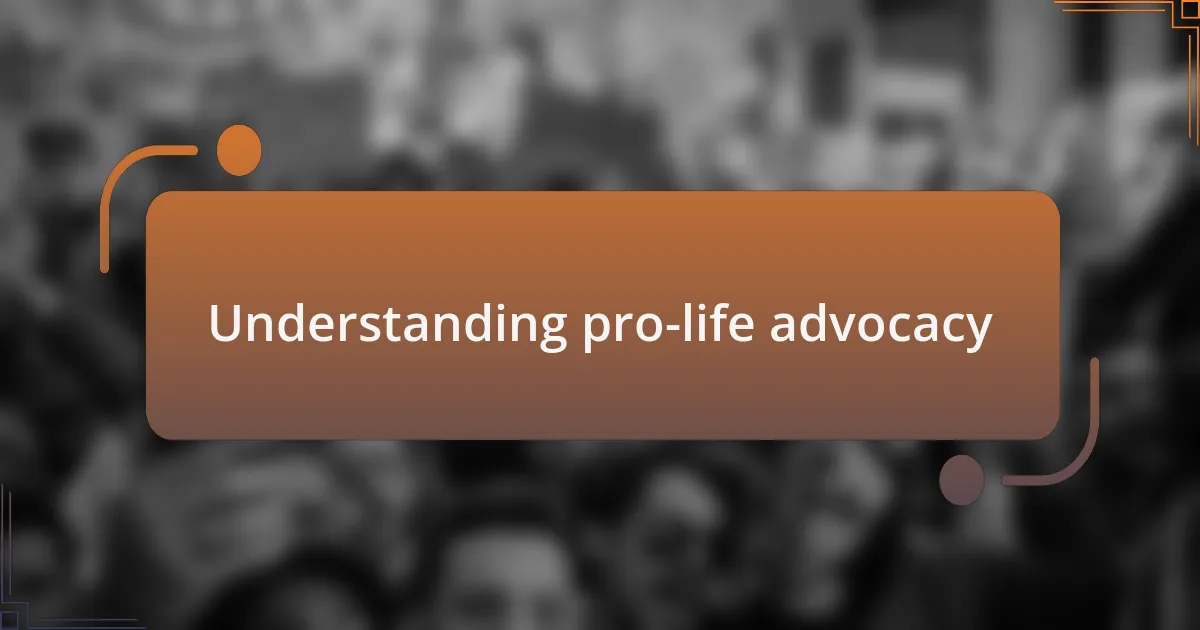
Understanding pro-life advocacy
Pro-life advocacy centers around the belief in the sanctity of all human life, emphasizing the importance of protecting the unborn. From my experience attending rallies and engaging in discussions, I’ve witnessed the passion that fuels this movement. It often makes me wonder: how can we convey the deep-seated value of life in a way that resonates with those who may not yet see it?
One poignant moment that stands out for me occurred during a local event where a young mother shared her story about choosing life against all odds. Her courage was palpable, and it inspired many to rethink their perspectives on pregnancy and choice. Stories like hers illuminate the emotional complexities surrounding life decisions and invite us to empathize with those facing them.
Understanding pro-life advocacy also means recognizing the diversity of voices within the movement. There are many angles to explore, from legal frameworks to personal narratives. This makes me think: aren’t we all striving for a society that values compassion and respect for each individual, regardless of their circumstances? Each perspective adds depth to the overarching message that life should be cherished and defended.
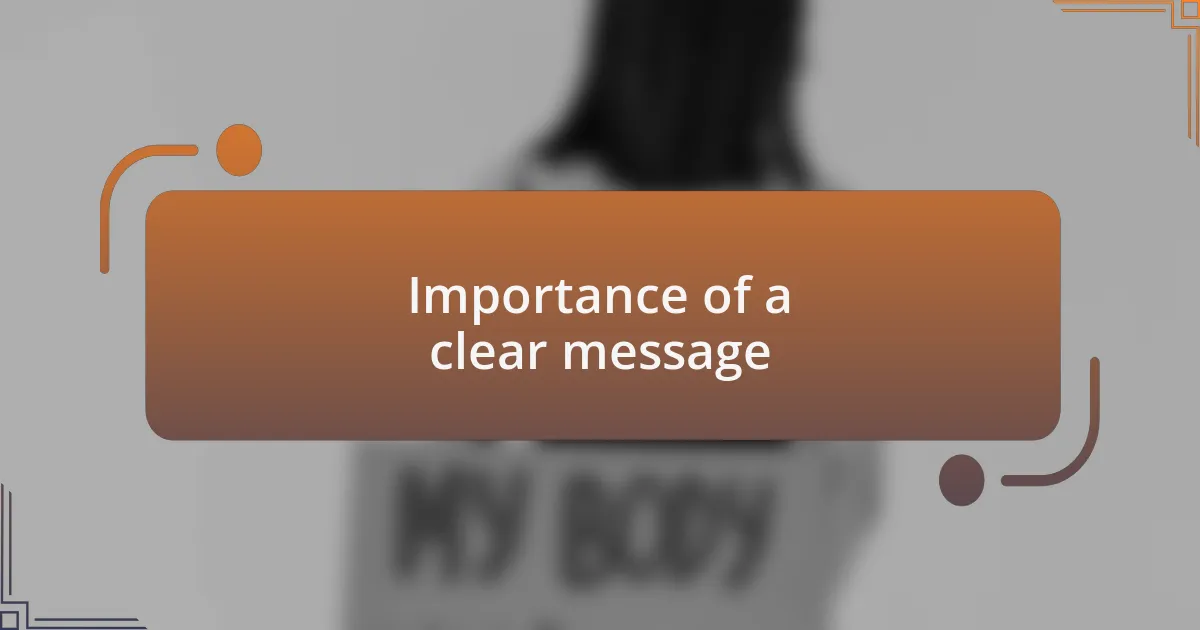
Importance of a clear message
A clear message in pro-life advocacy serves as the foundation for meaningful conversations. I once participated in a panel discussion where a lack of clarity from some speakers led to confusion and disengagement among the audience. It made me realize how crucial it is to articulate our beliefs in an understandable way. If we can’t communicate effectively, how can we expect to inspire others to join our cause?
In my experience, precision in messaging can also prevent misinterpretations that could undermine our goals. I remember when a friend shared a common pro-life slogan, yet the way it was framed sparked debate instead of solidarity. Who wants to engage in a divisive discussion when we aim to foster support? Tailoring our message to resonate with varied perspectives can transform skepticism into curiosity.
Moreover, a clear and compelling message empowers advocates to confidently address tough questions. I have found that when I am well-prepared to explain my stance, I not only convey my passion but also invite constructive dialogue. Don’t you think that presenting a united front is essential for our advocacy? The strength of our movement often lies in how well we communicate its core principles.
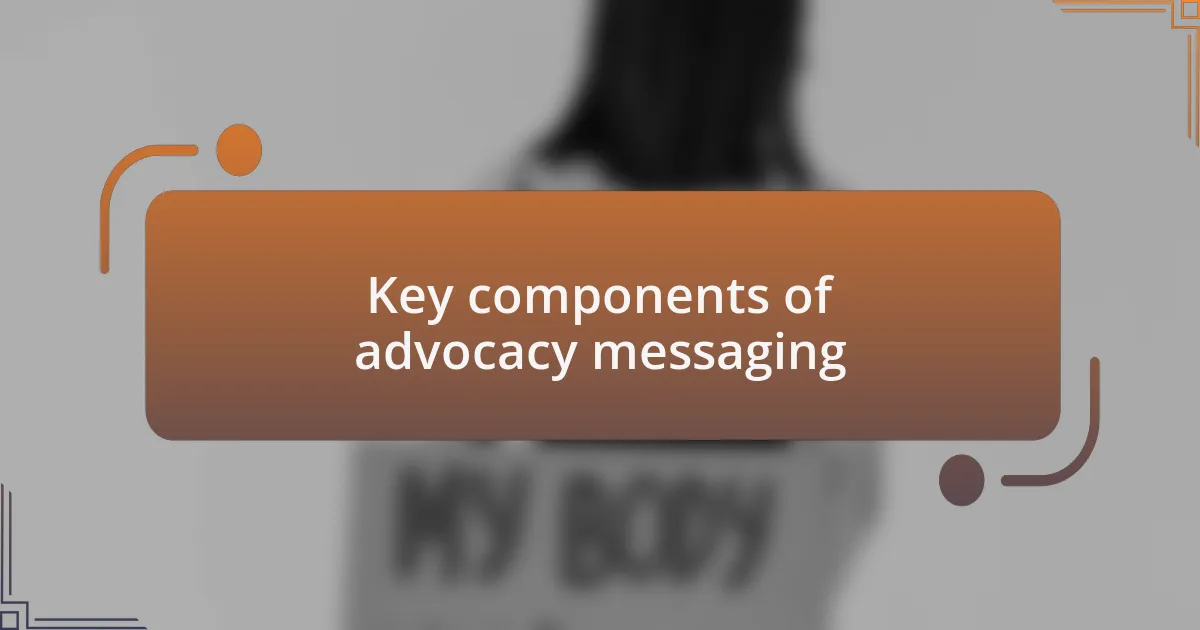
Key components of advocacy messaging
One of the key components of effective advocacy messaging is emotional resonance. I vividly recall an event where I shared a personal story of a friend who faced an unplanned pregnancy. Connecting my narrative to our cause sparked genuine conversations and moved people to reflect deeply on their own beliefs. Isn’t it interesting how a single story can create a bridge between differing viewpoints? This emotional appeal can transform abstract ideas into relatable experiences that stir empathy and understanding.
Another crucial aspect is the use of clear, concise language. When I first began advocating, I often slipped into jargon-heavy discussions that left listeners puzzled rather than engaged. Realizing this, I focused on simplifying my language and adapted complex concepts into digestible ideas. For instance, explaining the term “gestational limits” in a way that anyone can grasp has made my message more accessible. Wouldn’t you agree that clarity allows our message to travel further and reach more people?
Finally, consistency in messaging strengthens credibility. I once saw a fellow advocate shift her stance during a debate to align with a more popular viewpoint, which ultimately confused her supporters. From that experience, I learned the value of staying true to foundational beliefs while clearly articulating them. By being consistent and authentic, we build trust with both allies and those we seek to persuade. Have you ever noticed how consistency can be a beacon, guiding others to our cause?
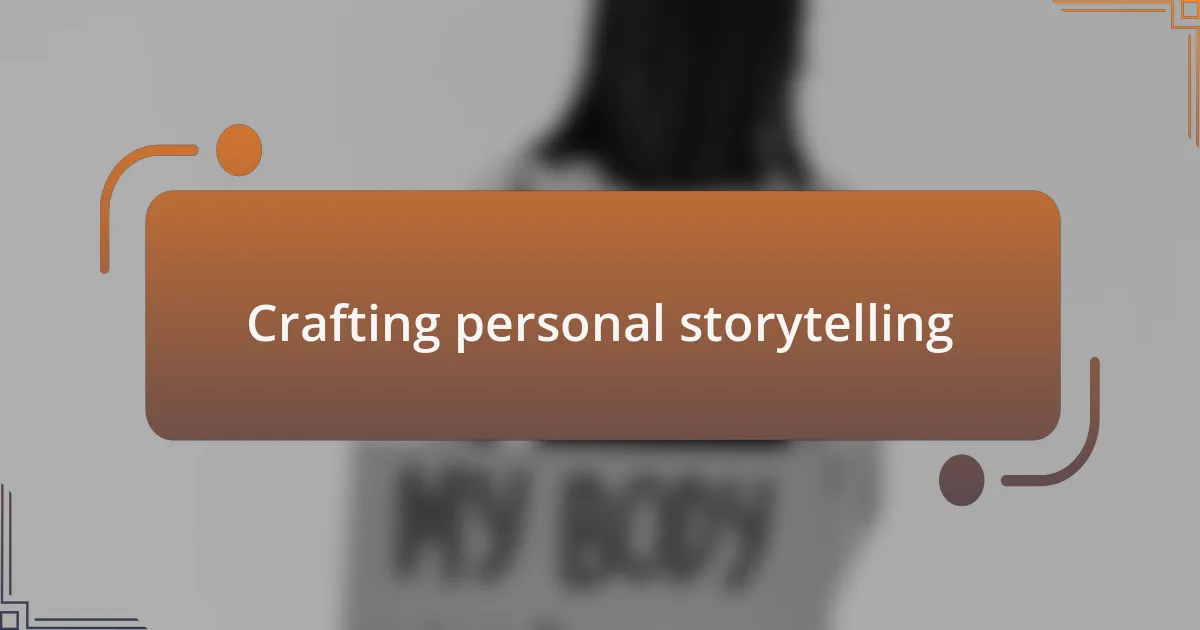
Crafting personal storytelling
Personal storytelling is a powerful tool in advocacy, allowing us to share our unique experiences in a way that resonates deeply with others. I remember the first time I spoke about my own journey as a young mother uncertain about my choices; the room fell silent as listeners absorbed the weight of my decisions. That moment reminded me how vulnerability can create genuine connections, making the complex issue of unplanned pregnancies more relatable and human.
Crafting these stories requires not just honesty, but also reflection. I often ask myself what key emotions I want to convey and how they relate to the larger narrative of our cause. For example, when I include details about the fear and hope I felt during my pregnancy, it underscores the profound struggle many might face. Isn’t it fascinating how sharing a simple moment of doubt can elevate the conversation and spark enthusiasm for change?
While I embrace the authenticity of personal storytelling, I’ve learned the importance of balance. We must ensure our anecdotes serve a purpose in advocating for our message rather than just sharing our life experiences. By drawing lessons from my own journey and connecting them to the broader theme of pro-life advocacy, I invite others to engage with the conversation. Do you find that shaping your narrative around clear themes empowers your message? I certainly do.
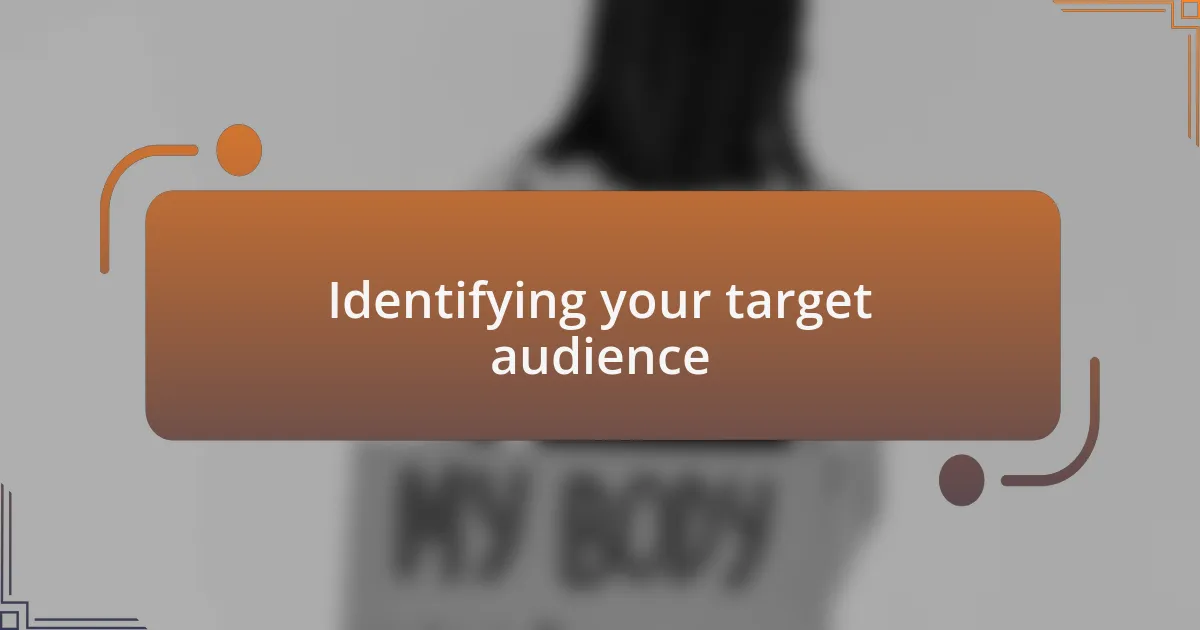
Identifying your target audience
Understanding your target audience is crucial in shaping your advocacy message. I recall hosting a local event where different voices in the pro-life community came together. By observing the diverse reactions from young parents, students, and seniors, I realized that each group had unique concerns and values, significantly influencing how I framed my message.
When I’ve tailored my communication for specific demographics, I’ve noticed a remarkable increase in engagement. For instance, addressing young adults’ perspectives on relationships and future planning allowed me to connect on a deeper emotional level. What specific concerns do you think resonate most with your audience? Identifying these nuances helps refine your approach and ensures that your message speaks directly to their hearts and minds.
Moreover, considering the backgrounds and experiences of your audience can lead to more meaningful dialogues. During a recent discussion with a group of teenagers about the importance of life choices, I was surprised to hear their candid views shaped by social media narratives. Engaging them required a shift from traditional arguments to relatable examples that considered their realities. In what ways can you personalize your outreach to connect authentically? It’s all about meeting people where they are and acknowledging their perspectives.
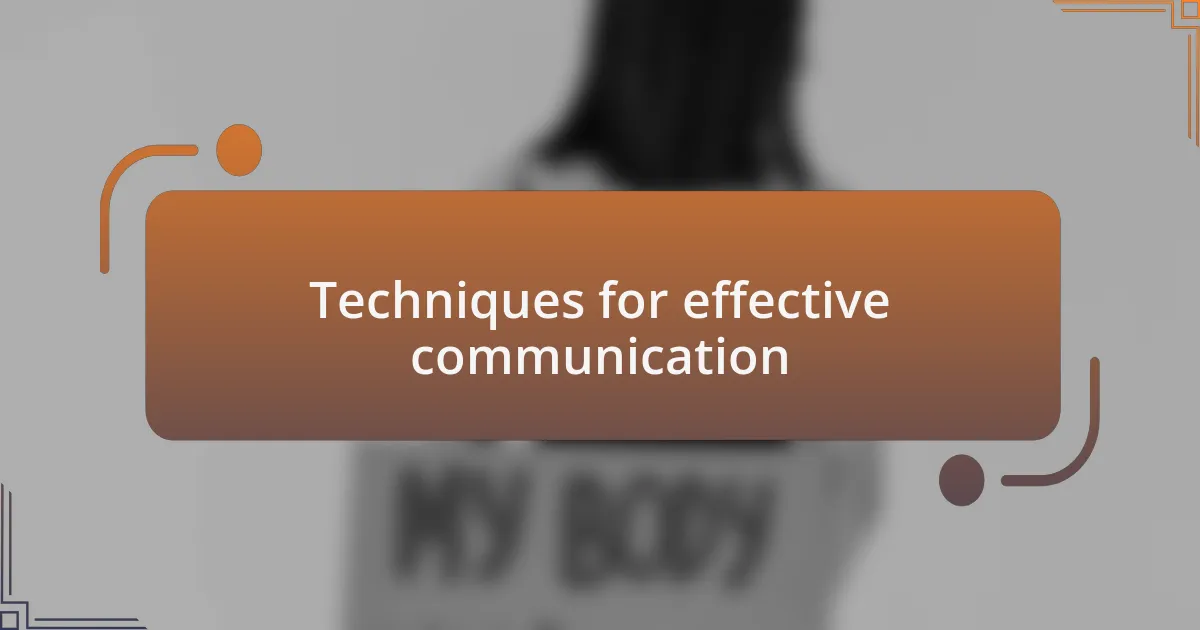
Techniques for effective communication
Effective communication in advocacy requires clarity and authenticity. I remember a time when I simplified complex statistics about fetal development into relatable stories. By sharing anecdotes from own experiences with pregnancy and parenting, I found that people connected more deeply—those personal touches made the data resonate on a human level. How often do we forget that behind every statistic, there’s a story waiting to be told?
Engaging your audience means choosing the right mediums as well. In my efforts, I’ve noticed the impact of social media platforms in reaching younger audiences. For instance, I created short, heartfelt videos about real-life stories from families. These snippets not only captured attention but also elicited emotional responses that lead to discussions. Have you considered how visual storytelling could enhance your advocacy efforts?
Additionally, active listening plays a pivotal role in communication. At a gathering where we discussed various pro-life perspectives, I focused on truly hearing others—reflecting their views back to them to show understanding. This approach fostered a respectful dialogue, illustrating that communication isn’t just about sharing your message; it’s also about building trust. In what ways can you incorporate listening into your conversations to make your advocacy more impactful?
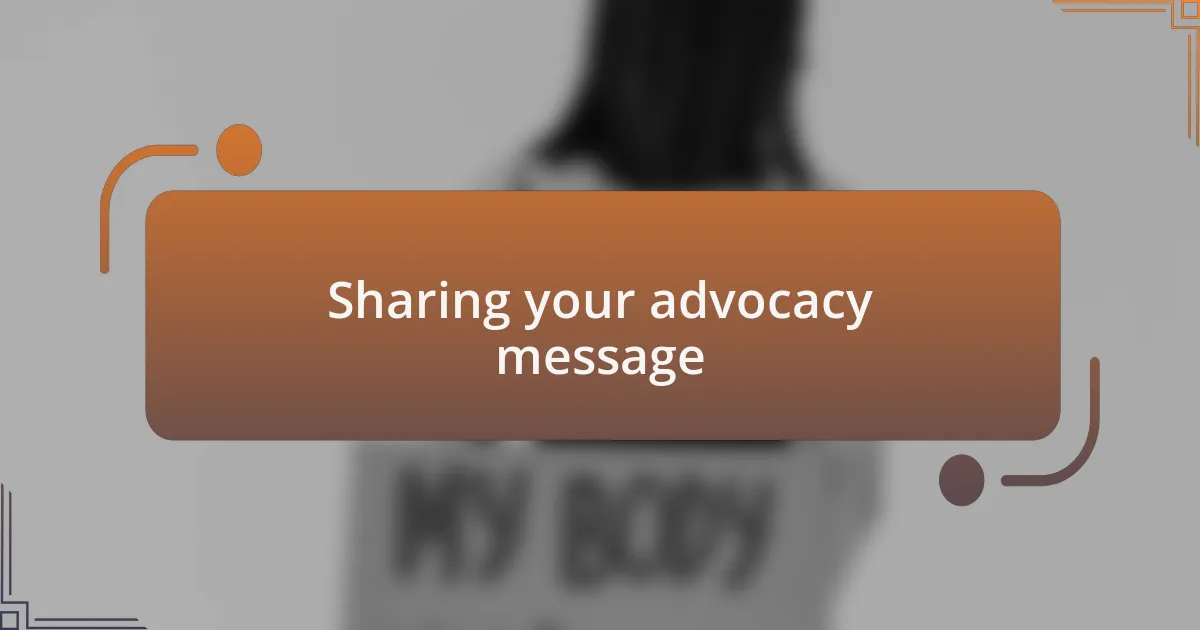
Sharing your advocacy message
Sharing your advocacy message effectively involves knowing your audience and connecting with them on an emotional level. For example, during a community event, I shared a story about a friend who faced a difficult decision regarding an unplanned pregnancy. The way I conveyed her feelings and struggles sparked genuine conversations among attendees, reminding everyone that advocacy isn’t just a debate—it’s about real lives and choices. Have you ever thought about how sharing personal stories could influence those around you?
Incorporating visuals can significantly enhance the way you share your message. I once used a simple infographic depicting the journey of life from conception to birth at a local meeting. People responded more positively to the visuals because it transformed abstract concepts into something tangible and relatable. What kinds of visuals have you considered using to amplify your advocacy?
Moreover, creating a space for dialogue is crucial. When I hosted a discussion group, I made it a point to encourage everyone to share their thoughts, no matter how differing they were from my own. This open atmosphere led to valuable exchanges and built a sense of community. Have you considered how fostering these conversations can empower your advocacy efforts?